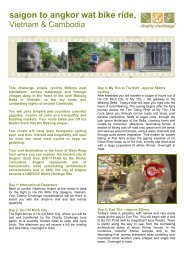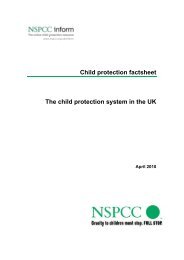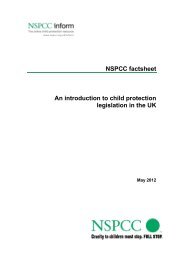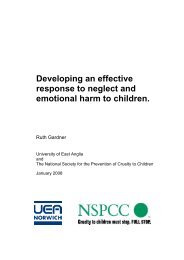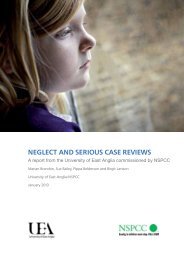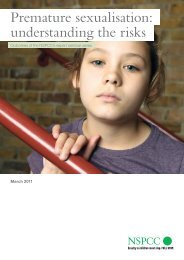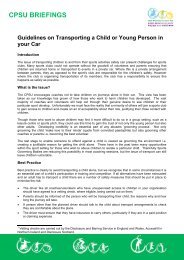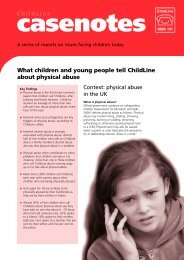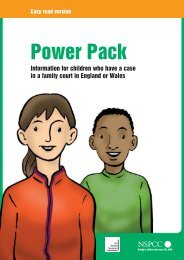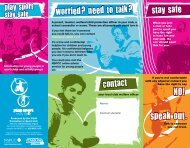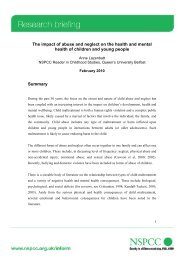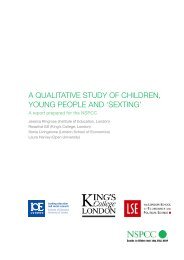Cleisiau ar blant / Bruises on children (bilingual Welsh ... - nspcc
Cleisiau ar blant / Bruises on children (bilingual Welsh ... - nspcc
Cleisiau ar blant / Bruises on children (bilingual Welsh ... - nspcc
Create successful ePaper yourself
Turn your PDF publications into a flip-book with our unique Google optimized e-Paper software.
Grwp Adolygu Systematig Amddiffyn Plant Cymru<br />
CORE-INFO:<br />
cleisiau <str<strong>on</strong>g>ar</str<strong>on</strong>g> <str<strong>on</strong>g>blant</str<strong>on</strong>g>
Mae’r wybodaeth sydd yn y daflen h<strong>on</strong> yn seiliedig <str<strong>on</strong>g>ar</str<strong>on</strong>g> adolygiad<br />
systematig o’r holl waith saf<strong>on</strong>ol sydd <str<strong>on</strong>g>ar</str<strong>on</strong>g> gael yn llenyddiaeth y<br />
byd ynghylch cleisiau <str<strong>on</strong>g>ar</str<strong>on</strong>g> <str<strong>on</strong>g>blant</str<strong>on</strong>g>. <str<strong>on</strong>g>Cleisiau</str<strong>on</strong>g> ydy’r anaf mwyaf cyffredin<br />
sydd gan <str<strong>on</strong>g>blant</str<strong>on</strong>g> sydd wedi cael eu cam-drin yn gorfforol. Dylai’r<br />
negeseu<strong>on</strong> allweddol hyn eich helpu i wybod pryd y dylid pryderu<br />
am gleisiau <str<strong>on</strong>g>ar</str<strong>on</strong>g> <str<strong>on</strong>g>blant</str<strong>on</strong>g>.<br />
Beth ydym ni’n ei wybod am gleisiau?<br />
• Ceir cysylltiad cryf rhwng gallu plentyn i symud a chleisiau.<br />
• Ar ôl i <str<strong>on</strong>g>blant</str<strong>on</strong>g> ddechrau symud cânt fwy o gleisiau drwy weithg<str<strong>on</strong>g>ar</str<strong>on</strong>g>eddau<br />
a damweiniau bob dydd.<br />
• Mae hi’n an<str<strong>on</strong>g>ar</str<strong>on</strong>g>ferol iawn gweld cleisiau <str<strong>on</strong>g>ar</str<strong>on</strong>g> fabi nad yw’n cropian eto,<br />
gan na all symud <str<strong>on</strong>g>ar</str<strong>on</strong>g> ei liwt ei hun.<br />
• Dim <strong>on</strong>d un o bob pum plentyn sy’n dechrau cerdded drwy afael mewn<br />
dodrefn sy’n cael cleisiau.<br />
• Mae gan y rhan fwyaf o <str<strong>on</strong>g>blant</str<strong>on</strong>g> sy’n gallu cerdded <str<strong>on</strong>g>ar</str<strong>on</strong>g> eu liwt eu hunain gleisiau.<br />
• Fel rheol caiff plant eu cleisio wrth ddisgyn neu d<str<strong>on</strong>g>ar</str<strong>on</strong>g>o i mewn i bethau <str<strong>on</strong>g>ar</str<strong>on</strong>g> eu ffordd.<br />
• Mae gan <str<strong>on</strong>g>blant</str<strong>on</strong>g> fwy o gleisiau yn ystod misoedd yr haf.<br />
Ble byddech chi’n disgwyl gweld cleisiau oherwydd<br />
anaf damweiniol?<br />
• Crimogau (blaen gwaelod y goes) a phengliniau ydy’r mannau mwyaf cyffredin<br />
lle mae plant sy’n cerdded neu’n dechrau cerdded yn cael cleisiau.<br />
• Mae’r rhan fwyaf o anafiadau damweiniol i’w gweld dros dd<str<strong>on</strong>g>ar</str<strong>on</strong>g>nau esgyrnog<br />
o’r corff, ee pengliniau a phenelinoedd, ac fe’u gwelir yn aml <str<strong>on</strong>g>ar</str<strong>on</strong>g> flaen y corff.<br />
• Gall plant bach sydd ddim <strong>on</strong>d yn dechrau cerdded <str<strong>on</strong>g>ar</str<strong>on</strong>g> eu pennau’u hunain<br />
d<str<strong>on</strong>g>ar</str<strong>on</strong>g>o a chleisio’u pennau – fel <str<strong>on</strong>g>ar</str<strong>on</strong>g>fer y talcen, y trwyn, canol yr ên neu gefn y pen.<br />
• Nid oes cleisiau’n ymddangos bob amser y bydd asgwrn yn torri, yn <str<strong>on</strong>g>ar</str<strong>on</strong>g>bennig<br />
mewn perthynas â thorri asennau neu doriadau metaffysaidd.<br />
Pryd ddylech chi boeni?<br />
Ceir rhai patrymau o gleisiau a all olygu bod y plentyn wedi’i gam-drin yn gorfforol.<br />
• Mae cleisiau cam-drin yn aml i’w gweld <str<strong>on</strong>g>ar</str<strong>on</strong>g> fannau meddal o’r corff, ee bochau,<br />
yr abdomen, y cefn a’r pen-ôl.<br />
• Y pen yw’r man mwyaf cyffredin i weld cleisiau cam-drin <str<strong>on</strong>g>ar</str<strong>on</strong>g> blentyn.<br />
• Mae clystyrau o gleisiau yn nodwedd gyffredin <str<strong>on</strong>g>ar</str<strong>on</strong>g> blentyn sy’n cael ei gam-drin.<br />
Gwelir y rhain yn aml <str<strong>on</strong>g>ar</str<strong>on</strong>g> dd<str<strong>on</strong>g>ar</str<strong>on</strong>g>n uchaf y fraich, ochr allan y glun, neu <str<strong>on</strong>g>ar</str<strong>on</strong>g> y corff.
• O ganlyniad i amddiffyn eu hunain, efallai y bydd gan <str<strong>on</strong>g>blant</str<strong>on</strong>g> sy’n cael eu cam-drin<br />
gleisiau <str<strong>on</strong>g>ar</str<strong>on</strong>g> dd<str<strong>on</strong>g>ar</str<strong>on</strong>g>n isaf y fraich, yr wyneb, y clustiau, yr abdomen, y cluniau, d<str<strong>on</strong>g>ar</str<strong>on</strong>g>n<br />
uchaf y fraich, cefn y goes, dwylo neu draed.<br />
• Yn aml bydd ôl yr <str<strong>on</strong>g>ar</str<strong>on</strong>g>f neu’r llaw a ddefnyddiwyd i’w weld mewn cleisiau cam-drin.<br />
• Nid oes clais yn ymddangos bob tro y bydd plentyn yn torri asgwrn neu’n<br />
niweidio’i ben yn annamweiniol.<br />
• Mae cleisiau sydd â petechiae (dotiau o waed dan y croen) o’u cwmpas i’w<br />
gweld yn fwy cyffredin <str<strong>on</strong>g>ar</str<strong>on</strong>g> <str<strong>on</strong>g>blant</str<strong>on</strong>g> sydd wedi cael eu cam-drin nag <str<strong>on</strong>g>ar</str<strong>on</strong>g> <str<strong>on</strong>g>blant</str<strong>on</strong>g> a anafir<br />
yn ddamweiniol.<br />
• Gall cleisio i groen y pen a’r llygaid yn chwyddo, pan nad oes toriad i’r penglog,<br />
ddigwydd os yw’r plentyn wedi cael ei ‘sgalpio’ – hy y gwallt wedi’i dynnu’n<br />
galed iawn.<br />
Allwch chi ddweud yn gywir pa mor hen ydy clais?<br />
Yr ateb yw na. Ar hyn o bryd amcangyfrifir pa mor hen ydy clais drwy asesu lliw’r<br />
clais gyda’ch llygaid. Mae llai na 50 y cant o’r rheini sy’n amcangyfrif oed clais yn y<br />
ffordd h<strong>on</strong> yn gwneud hynny’n gywir. Mae’r dystiolaeth yn dangos na allwn ddweud<br />
pa mor hen ydy clais drwy asesu’r lliw – un ai drwy asesiad clinigol neu ffotograff. Mae<br />
ym<str<strong>on</strong>g>ar</str<strong>on</strong>g>ferydd sy’n cynnig amcan pendant o oed clais <str<strong>on</strong>g>ar</str<strong>on</strong>g> blentyn drwy asesu’r clais â’i<br />
lygaid yn gwneud hynny <str<strong>on</strong>g>ar</str<strong>on</strong>g> sail ei brofiad ei hun heb dystiolaeth gyhoeddedig ddig<strong>on</strong>ol.<br />
Goblygiadau i ym<str<strong>on</strong>g>ar</str<strong>on</strong>g>fer<br />
Ni ddylid deh<strong>on</strong>gli clais <str<strong>on</strong>g>ar</str<strong>on</strong>g> ei ben ei hun a dylid ei asesu bob amser yng nghyd-destun<br />
hanes meddygol a chymdeithasol y plentyn, ei gam datblygu a’r eglurhad a roddir.<br />
Dylai meddyg weld unrhyw blentyn yn ddiymdroi os oes ganddo unrhyw <str<strong>on</strong>g>ar</str<strong>on</strong>g>wyddi<strong>on</strong><br />
o boen neu salwch a dim eglurhad dros hynny.<br />
Mae cleisiau sy’n awgrymu ei bod hi’n bosibl bod y plentyn wedi’i gam-drin<br />
yn gorfforol yn cynnwys:<br />
• cleisiau <str<strong>on</strong>g>ar</str<strong>on</strong>g> <str<strong>on</strong>g>blant</str<strong>on</strong>g> na allant symud <str<strong>on</strong>g>ar</str<strong>on</strong>g> eu liwt eu hunain<br />
• cleisiau <str<strong>on</strong>g>ar</str<strong>on</strong>g> fabis<br />
• cleisiau nad ydynt <str<strong>on</strong>g>ar</str<strong>on</strong>g> dd<str<strong>on</strong>g>ar</str<strong>on</strong>g>nau esgyrnog amlwg o’r corff<br />
• cleisiau <str<strong>on</strong>g>ar</str<strong>on</strong>g> yr wyneb, y cefn, yr abdomen, y breichiau, y pen-ôl, y clustiau a’r dwylo<br />
• nifer o gleisiau mewn clystyrau<br />
• nifer o gleisiau o’r un siâp<br />
• cleisiau sy’n dangos ôl rhywbeth – <str<strong>on</strong>g>ar</str<strong>on</strong>g>f neu gortyn<br />
• cleisiau â petechiae (dotiau o waed dan y gwaed) o’u cwmpas.
Mae’r daflen h<strong>on</strong> yn seiliedig <str<strong>on</strong>g>ar</str<strong>on</strong>g> waith Grwp ˆ<br />
Adolygu Systematig Amddiffyn<br />
Plant Cymru sy’n cyflawni rhaglen dreigl o adolygiadau systematig o lenyddiaeth<br />
ymchwil gyhoeddedig am agweddau <str<strong>on</strong>g>ar</str<strong>on</strong>g> gam-drin plant yn gorfforol.<br />
Mae hwn yn brosiect <str<strong>on</strong>g>ar</str<strong>on</strong>g> y cyd rhwng Adran Iechyd Plant – Prifysgol Caerdydd<br />
a’r NSPCC.<br />
I gael manyli<strong>on</strong> llawn a’r wybodaeth ddiwedd<str<strong>on</strong>g>ar</str<strong>on</strong>g>af am yr adolygiadau systematig,<br />
ewch i’r wefan CORE-INFO yn www.core-info.cf.ac.uk<br />
Diwedd<str<strong>on</strong>g>ar</str<strong>on</strong>g>wyd yr adolygiad systematig ym mis Mehefin 2009.<br />
Diwedd<str<strong>on</strong>g>ar</str<strong>on</strong>g>wyd y daflen ‘core-info’ ym mis Gorffennaf 2009.<br />
Gallwch lwytho’r daflen oddi <str<strong>on</strong>g>ar</str<strong>on</strong>g> y we yn:<br />
www.<strong>nspcc</strong>.org.uk/core-info<br />
I <str<strong>on</strong>g>ar</str<strong>on</strong>g>chebu rhagor o gopïau, ewch <str<strong>on</strong>g>ar</str<strong>on</strong>g>-lein, neu cysylltwch â Chyhoeddiadau NSPCC:<br />
Post: West<strong>on</strong> House, 42 Curtain Road, Llundain EC2A 3NH<br />
E-bost: publicati<strong>on</strong>s@<strong>nspcc</strong>.org.uk<br />
Ffôn: 020 7825 7422 Ffacs: 020 7825 2763<br />
I gael rhagor o wybodaeth am adnoddau dysgu amddiffyn plant yr NSPCC,<br />
ewch i: www.<strong>nspcc</strong>.org.uk/le<str<strong>on</strong>g>ar</str<strong>on</strong>g>ningresources<br />
Pan fyddwch chi’n poeni am blentyn, si<str<strong>on</strong>g>ar</str<strong>on</strong>g>adwch gyda ni.<br />
Beth bynnag fo’ch pryder, mae llinell gymorth NSPCC yma i<br />
gynnig cymorth, cyngor a chefnogaeth. Does dim rhaid i chi<br />
ddweud pwy ydych chi.<br />
Ff<strong>on</strong>iwch 0808 800 5000<br />
neu anf<strong>on</strong> e-bost i help@<strong>nspcc</strong>.org.uk<br />
© Hawlfraint NSPCC a Phrifysgol Caerdydd, 2009. Rhifau cofrestru elusen yr NSPCC 216401 a SC037717. Ffotograffau gan Paul Close. Defnyddiwyd modelau. 5632/09.
CORE-INFO:<br />
bruises <strong>on</strong> <strong>children</strong>
The informati<strong>on</strong> in this leaflet is based <strong>on</strong> a systematic review of all<br />
the quality work in the world literature about bruising <strong>on</strong> <strong>children</strong>.<br />
Bruising is the most comm<strong>on</strong> injury to a child who has been<br />
physically abused. These key messages should help you to know<br />
when to be c<strong>on</strong>cerned about bruising <strong>on</strong> <strong>children</strong>.<br />
What do we know about bruising?<br />
• Bruising is str<strong>on</strong>gly related to mobility.<br />
• Once <strong>children</strong> <str<strong>on</strong>g>ar</str<strong>on</strong>g>e mobile they sustain bruises from everyday<br />
activities and accidents.<br />
• Bruising in a baby who is not yet crawling, and therefore has<br />
no independent mobility, is very unusual.<br />
• Only <strong>on</strong>e in five infants who is st<str<strong>on</strong>g>ar</str<strong>on</strong>g>ting to walk by holding <strong>on</strong> to<br />
the furniture has bruises.<br />
• Most <strong>children</strong> who <str<strong>on</strong>g>ar</str<strong>on</strong>g>e able to walk independently have bruises.<br />
• <str<strong>on</strong>g>Bruises</str<strong>on</strong>g> usually happen when <strong>children</strong> fall over or bump<br />
into objects in their way.<br />
• Children have more bruises during the summer m<strong>on</strong>ths.<br />
Where would you expect to see bruising<br />
from an accidental injury?<br />
• The shins and the knees <str<strong>on</strong>g>ar</str<strong>on</strong>g>e the most likely places where<br />
<strong>children</strong> who <str<strong>on</strong>g>ar</str<strong>on</strong>g>e walking, or st<str<strong>on</strong>g>ar</str<strong>on</strong>g>ting to walk, get bruised.<br />
• Most accidental bruises <str<strong>on</strong>g>ar</str<strong>on</strong>g>e seen over b<strong>on</strong>y p<str<strong>on</strong>g>ar</str<strong>on</strong>g>ts of the body –<br />
eg, knees and elbows – and <str<strong>on</strong>g>ar</str<strong>on</strong>g>e often seen <strong>on</strong> the fr<strong>on</strong>t of the body.<br />
• Infants who <str<strong>on</strong>g>ar</str<strong>on</strong>g>e just st<str<strong>on</strong>g>ar</str<strong>on</strong>g>ting to walk unsupported may bump and<br />
bruise their heads – usually the forehead, nose, centre of their<br />
chin or back of the head.<br />
• It is comm<strong>on</strong> to have fractures, p<str<strong>on</strong>g>ar</str<strong>on</strong>g>ticul<str<strong>on</strong>g>ar</str<strong>on</strong>g>ly rib or metaphyseal<br />
fractures, without any bruising.<br />
When should you be c<strong>on</strong>cerned?<br />
There <str<strong>on</strong>g>ar</str<strong>on</strong>g>e some patterns of bruising that may mean physical abuse has taken place.<br />
• Abusive bruises often occur <strong>on</strong> soft p<str<strong>on</strong>g>ar</str<strong>on</strong>g>ts of the body –<br />
eg, cheeks, abdomen, back and buttocks.<br />
• The head is by f<str<strong>on</strong>g>ar</str<strong>on</strong>g> the comm<strong>on</strong>est site of bruising in child abuse.
• Clusters of bruises <str<strong>on</strong>g>ar</str<strong>on</strong>g>e a comm<strong>on</strong> feature in abused <strong>children</strong>.<br />
These <str<strong>on</strong>g>ar</str<strong>on</strong>g>e often <strong>on</strong> the upper <str<strong>on</strong>g>ar</str<strong>on</strong>g>m, outside of the thigh, or <strong>on</strong> the body.<br />
• As a result of defending themselves, abused <strong>children</strong> may have bruising <strong>on</strong> the<br />
fore<str<strong>on</strong>g>ar</str<strong>on</strong>g>m, face, e<str<strong>on</strong>g>ar</str<strong>on</strong>g>s, abdomen, hip, upper <str<strong>on</strong>g>ar</str<strong>on</strong>g>m, back of the leg, hands or feet.<br />
• Abusive bruises can often c<str<strong>on</strong>g>ar</str<strong>on</strong>g>ry the imprint of the implement used or the hand.<br />
• N<strong>on</strong>-accidental head injury or fractures can occur without bruising.<br />
• <str<strong>on</strong>g>Bruises</str<strong>on</strong>g> which have petechiae (dots of blood under the skin) <str<strong>on</strong>g>ar</str<strong>on</strong>g>ound them <str<strong>on</strong>g>ar</str<strong>on</strong>g>e<br />
found more comm<strong>on</strong>ly in <strong>children</strong> who have been abused than in those<br />
injured accidentally.<br />
• Severe bruising to the scalp, with swelling <str<strong>on</strong>g>ar</str<strong>on</strong>g>ound the eyes and no skull fracture,<br />
may occur if the child has been “scalped” – ie, had their hair pulled violently.<br />
Can you age a bruise accurately?<br />
The answer is no. Estimates of the age of a bruise <str<strong>on</strong>g>ar</str<strong>on</strong>g>e currently based <strong>on</strong> an<br />
assessment of the colour of the bruise with the naked eye. The accuracy of<br />
observers who estimate the age of a bruise visually is no better than 50 per cent.<br />
The evidence is that we cannot accurately age a bruise from an assessment of<br />
colour – from either a clinical assessment or a photograph. A practiti<strong>on</strong>er who offers<br />
a definitive estimate of the age of a bruise in a child by assessment with the naked<br />
eye is doing so from their own experience without adequate published evidence.<br />
Implicati<strong>on</strong>s for practice<br />
A bruise should never be interpreted in isolati<strong>on</strong> and must always be assessed in<br />
the c<strong>on</strong>text of the child’s medical and social history, developmental stage and<br />
explanati<strong>on</strong> given. Any child who has unexplained signs of pain or illness should<br />
be seen promptly by a doctor.<br />
Bruising that suggests the possibility of physical child abuse includes:<br />
• bruising in <strong>children</strong> who <str<strong>on</strong>g>ar</str<strong>on</strong>g>e not independently mobile<br />
• bruising in babies<br />
• bruises that <str<strong>on</strong>g>ar</str<strong>on</strong>g>e seen away from b<strong>on</strong>y prominences<br />
• bruises to the face, back, abdomen, <str<strong>on</strong>g>ar</str<strong>on</strong>g>ms, buttocks, e<str<strong>on</strong>g>ar</str<strong>on</strong>g>s and hands<br />
• multiple bruises in clusters<br />
• multiple bruises of uniform shape<br />
• bruises that c<str<strong>on</strong>g>ar</str<strong>on</strong>g>ry an imprint – of an implement or cord<br />
• bruises with petechiae (dots of blood under the skin) <str<strong>on</strong>g>ar</str<strong>on</strong>g>ound them.
This leaflet is based <strong>on</strong> the work of the <strong>Welsh</strong> Child Protecti<strong>on</strong> Systematic Review<br />
Group who <str<strong>on</strong>g>ar</str<strong>on</strong>g>e engaged in a rolling programme of systematic reviews of published<br />
rese<str<strong>on</strong>g>ar</str<strong>on</strong>g>ch literature <strong>on</strong> aspects of physical child abuse.<br />
This is a collaborative project between the Dep<str<strong>on</strong>g>ar</str<strong>on</strong>g>tment of Child Health – C<str<strong>on</strong>g>ar</str<strong>on</strong>g>diff<br />
University and the NSPCC.<br />
For full details and the latest informati<strong>on</strong> <strong>on</strong> the systematic reviews,<br />
visit the CORE-INFO website www.core-info.cf.ac.uk<br />
Systematic review updated in June 2009.<br />
Core-info leaflet updated in July 2009.<br />
You can download the leaflet <strong>on</strong>line at:<br />
www.<strong>nspcc</strong>.org.uk/core-info<br />
To order additi<strong>on</strong>al copies go <strong>on</strong>line, or c<strong>on</strong>tact NSPCC Publicati<strong>on</strong>s:<br />
Post: West<strong>on</strong> House, 42 Curtain Road, L<strong>on</strong>d<strong>on</strong> EC2A 3NH<br />
Email: publicati<strong>on</strong>s@<strong>nspcc</strong>.org.uk<br />
Tel: 020 7825 7422 Fax: 020 7825 2763<br />
For more informati<strong>on</strong> about NSPCC child protecti<strong>on</strong> le<str<strong>on</strong>g>ar</str<strong>on</strong>g>ning resources<br />
visit: www.<strong>nspcc</strong>.org.uk/le<str<strong>on</strong>g>ar</str<strong>on</strong>g>ningresources<br />
When you’re worried about a child, talk to us.<br />
Whatever your c<strong>on</strong>cern, the NSPCC Helpline is here<br />
to offer help, advice and support. You d<strong>on</strong>’t have to<br />
say who you <str<strong>on</strong>g>ar</str<strong>on</strong>g>e.<br />
Call 0808 800 5000 or email help@<strong>nspcc</strong>.org.uk<br />
© Copyright NSPCC and C<str<strong>on</strong>g>ar</str<strong>on</strong>g>diff University, 2009. NSPCC registered ch<str<strong>on</strong>g>ar</str<strong>on</strong>g>ity numbers 216401 and SC037717. Photography by Paul Close. Posed by models. 5632/09.



